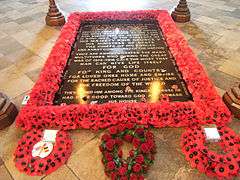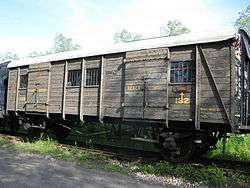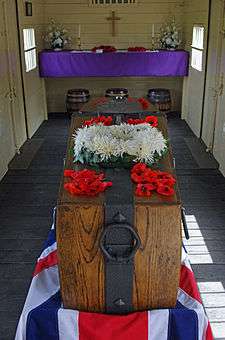The Unknown Warrior
| The Unknown Warrior | |
|---|---|
| United Kingdom | |
 The Tomb of the Unknown Warrior | |
| For the unknown war dead, wherever they fell | |
| Unveiled | 11 November 1920 |
| Location |
51°29′57.66″N 0°7′39.42″W / 51.4993500°N 0.1276167°WCoordinates: 51°29′57.66″N 0°7′39.42″W / 51.4993500°N 0.1276167°W near London, England |
The British tomb of The Unknown Warrior holds an unidentified British soldier killed on a European battlefield during the First World War.[1] He was buried in Westminster Abbey, London on 11 November 1920, simultaneously with a similar interment of a French unknown soldier at the Arc de Triomphe in France, making both tombs the first to honour the unknown dead of the First World War. It is the first example of a Tomb of the Unknown Soldier.
History of the Unknown Warrior
Origins
The idea of a Tomb of the Unknown Warrior was first conceived in 1916 by the Reverend David Railton, who, while serving as an army chaplain on the Western Front, had seen a grave marked by a rough cross, which bore the pencil-written legend 'An Unknown British Soldier'.[2]
He wrote to the Dean of Westminster in 1920 proposing that an unidentified British soldier from the battlefields in France be buried with due ceremony in Westminster Abbey "amongst the kings" to represent the many hundreds of thousands of Empire dead. The idea was strongly supported by the Dean and the then Prime Minister David Lloyd George.[2]
Selection, arrival and ceremony


Arrangements were placed in the hands of Lord Curzon of Kedleston who prepared in committee the service and location. Suitable remains were exhumed from various battlefields and brought to the chapel at Saint-Pol-sur-Ternoise near Arras, France on the night of 7 November 1920. The bodies were received by the Reverend George Kendall OBE. Brigadier L.J. Wyatt and Lieutenant Colonel E.A.S. Gell of the Directorate of Graves Registration and Enquiries went into the chapel alone. The remains were then placed in six plain coffins each covered by Union Flags: the two officers did not know from which battlefield any individual soldier had come. Brigadier Wyatt with closed eyes rested his hand on one of the coffins. The other soldiers were then taken away for reburial by Kendall.
The coffin of the unknown warrior then stayed at the chapel overnight and on the afternoon of 8 November, it was transferred under guard and escorted by Kendall, with troops lining the route, from Ste Pol to the medieval castle within the ancient citadel at Boulogne. For the occasion, the castle library was transformed into a chapelle ardente: a company from the French 8th Infantry Regiment, recently awarded the Légion d'Honneur en masse,[3] stood vigil overnight.[1]
The following morning, two undertakers entered the castle library and placed the coffin into a casket of the oak timbers of trees from Hampton Court Palace.[1] The casket was banded with iron, and a medieval crusader's sword chosen by The King personally from the Royal Collection was affixed to the top and surmounted by an iron shield bearing the inscription 'A British Warrior who fell in the Great War 1914–1918 for King and Country'.[1]
The casket was then placed onto a French military wagon, drawn by six black horses. At 10.30 am, all the church bells of Boulogne tolled; the massed trumpets of the French cavalry and the bugles of the French infantry played Aux Champs (the French "Last Post").[1] Then, the mile-long procession—led by one thousand local schoolchildren and escorted by a division of French troops—made its way down to the harbour.[1]
At the quayside, Marshal Foch saluted the casket before it was carried up the gangway of the destroyer, HMS Verdun, and piped aboard with an admiral's call. The Verdun slipped anchor just before noon and was joined by an escort of six battleships.[1] As the flotilla carrying the casket closed on Dover Castle it received a 19-gun Field Marshal's salute. It was landed at Dover Marine Railway Station at the Western Docks on 10 November. The body of the Unknown Warrior was carried to London in South Eastern and Chatham Railway General Utility Van No.132, which had previously carried the bodies of Edith Cavell and Charles Fryatt. The van has been preserved by the Kent and East Sussex Railway.[4] The train went to Victoria Station, where it arrived at platform 8 at 8.32 pm that evening and remained overnight. (A plaque at Victoria Station marks the site: every year on 10 November, a small Remembrance service, organised by The Western Front Association, takes place between platforms 8 and 9.)
On the morning of 11 November 1920, the casket was placed onto a gun carriage of the Royal Horse Artillery and drawn by six horses through immense and silent crowds. As the cortege set off, a further Field Marshal's salute was fired in Hyde Park.[5] The route followed was Hyde Park Corner, The Mall, and to Whitehall where the Cenotaph, a "symbolic empty tomb",[6] was unveiled by King-Emperor George V. The cortège was then followed by The King, the Royal Family and ministers of state to Westminster Abbey, where the casket was borne into the West Nave of the Abbey flanked by a guard of honour of one hundred recipients of the Victoria Cross.
The guests of honour were a group of about one hundred women.[1] They had been chosen because they had each lost their husband and all their sons in the war.[1] "Every woman so bereft who applied for a place got it".[1]
The coffin was then interred in the far western end of the Nave, only a few feet from the entrance, in soil brought from each of the main battlefields, and covered with a silk pall. Servicemen from the armed forces stood guard as tens of thousands of mourners filed silently past. The ceremony appears to have served as a form of catharsis for collective mourning on a scale not previously known.[1]
The grave was then capped with a black Belgian marble stone (the only tombstone in the Abbey on which it is forbidden to walk) featuring this inscription, composed by Herbert Edward Ryle, Dean of Westminster, engraved with brass from melted down wartime ammunition:
Beneath this stone rests the body
Of a British warrior
Unknown by name or rank
Brought from France to lie among
The most illustrious of the land
And buried here on Armistice Day
11 Nov: 1920, in the presence of
His Majesty King George V
His Ministers of State
The Chiefs of his forces
And a vast concourse of the nation
Thus are commemorated the many
Multitudes who during the Great
War of 1914 – 1918 gave the most that
Man can give life itself
For God
For King and country
For loved ones home and empire
For the sacred cause of justice and
The freedom of the world
They buried him among the kings because he
Had done good toward God and toward
His house
Around the main inscription are four texts:
The Lord knoweth them that are his (top)
Unknown and yet well known, dying and behold we live (side)
Greater love hath no man than this (side)
In Christ shall all be made alive (base)
Later history
A year later, on 17 October 1921, the unknown warrior was given the United States' highest award for valour, the Medal of Honor, from the hand of General John Pershing; it hangs on a pillar close to the tomb. On 11 November 1921, the American Unknown Soldier was reciprocally awarded the Victoria Cross.
When Elizabeth Bowes-Lyon married the future King George VI on 26 April 1923, she laid her bouquet at the Tomb on her way into the Abbey, as a tribute to her brother Fergus who had died at the Battle of Loos in 1915 (and whose name was then listed among those of the missing on the Loos Memorial, although in 2012 a new headstone was erected in the Quarry Cemetery, Vermelles).[1][7][8] Royal brides married at the Abbey now have their bouquets laid on the tomb the day after the wedding and all of the official wedding photographs have been taken.[9][10] It is also the only tomb not to have been covered by a special red carpet for the wedding of Prince Albert, Duke of York, and Elizabeth Bowes-Lyon.[9]
Before she died in 2002, Queen Elizabeth The Queen Mother (the same Elizabeth who first laid her wedding bouquet at the tomb) expressed the wish for her wreath to be placed on the Tomb of the Unknown Warrior. Her daughter, Queen Elizabeth II, laid the wreath the day after the funeral.[11]
The British Unknown Warrior came 76th in the 100 Great Britons poll.[12] The LMS-Patriot Project a charitable organisation, is building a new steam locomotive that will carry the name The Unknown Warrior. The new loco has been endorsed by the Royal British Legion as the new National Memorial Engine. A public appeal to build the locomotive was launched in 2008. The Unknown Warrior is expected to be complete by 2018—the 100th Anniversary of the Armistice, if sufficient funds can be raised.[13]
The day after the wedding of William and Catherine Duke and Duchess of Cambridge on 29 April 2011, the Duchess' wedding bouquet was laid on the tomb.[14][15]
Heads of state from over 70 countries have lain wreaths in memoriam of the Unknown Warrior.[16]
Related memorials
There have been three related memorials erected since 1920 for the Unknown Warrior:
- St. Pol where the Unknown Warrior was selected
- Dover harbour at the cruise terminal where the Unknown Warrior was brought ashore
- Victoria Station, London, where the Unknown Warrior rested before his burial on 11 November
See also
- Tomb of the Unknown Soldier – includes a listing of unknown soldier memorials around the world
- Tower Hill Memorial
- World War I memorials
Notes
- 1 2 3 4 5 6 7 8 9 10 11 12 Hanson, Chapters 23 & 24
- 1 2 Allingham, Henry; Goodwin, Dennis (2011). Kitchener's Last Volunteer: The Life of Henry Allingham, the Oldest Surviving Veteran of the Great War. Random House. p. 132.
- ↑ "Collectivité décorées de la Légion d'honneur, 8eme régiment d'infanterie de ligne" (in French). France-Phaleristique.com.
- ↑ "Bid to save WWI heroes' carriage". BBC News. 3 December 2009. Retrieved 3 December 2009.
- ↑ Memorial Services (November 11th) Committee, Maurice Hankey, Cabinet Office Papers, 1915–1978, The National Archives. (CAB 24/114).
- ↑ Holmes, p. 630
- ↑ "Casualty Details: Bowes-Lyon, The Hon Fergus". Commonwealth War Graves Commission. Retrieved 16 August 2012.
- ↑ "Final resting place of Queen's uncle discovered nearly a century after his death". Daily Record. 19 August 2012. Retrieved 20 August 2012.
- 1 2 "Queen releases 60 wedding facts". BBC News. 18 November 2007. Retrieved 18 November 2007.
- ↑ Rayment, Sean (1 May 2011). "Royal wedding: Kate Middleton's bridal bouquet placed at Grave of Unknown Warrior". The Daily Telegraph. London. Retrieved 1 May 2011.
- ↑ "Details of the Queen Mother's funeral". CNN. 7 April 2002. Retrieved 25 May 2010.
- ↑ Cooper, John (2002). Great Britons. London: National Portrait Gallery. p. 9. ISBN 1-85514-507-3.
- ↑ "The LMS Patriot Project". The LMS-Patriot Company Ltd. Retrieved 24 October 2014.
- ↑ "Touching tribute from a Royal bride: Kate's bouquet returns to Westminster Abbey to lie on the grave of the unknown soldier". Daily Mail. London. 30 April 2011. Retrieved 25 July 2012.
- ↑ "Queues at Westminster Abbey to view royal flowers". BBC News. 2 May 2011. Retrieved 2 July 2012.
- ↑ "Barack Obama lays memorial wreath at Westminster Abbey". The Daily Telegraph. London. 24 May 2011.
References
- Hanson, Neil (2005). The Unknown Soldier. London: Doubleday. ISBN 978-0-552-14976-1.
- Holmes, Richard (2004). Tommy: The British Soldier on the Western Front 1914–1918. London: Harper Collins. ISBN 978-0-00-713751-0.
Further reading
- The Story of the British Unknown Warrior, M. Gavaghan
| Wikimedia Commons has media related to Tomb of the Unknown Warrior. |
External links
- The Unknown Warrior (Westminster Abbey)
- What is the Grave of the Unknown Warrior? – The Dean of Westminster Abbey, the Very Reverend Dr John Hall explains its significance
- The LMS-Patriot Project
- "Unknown Soldier of World War I (British)". Find a Grave. 28 May 1998. Retrieved 30 November 2011.
- Hanson discusses Unknown Soldiers: The Story of the Missing of the First World War at the Pritzker Military Museum & Library